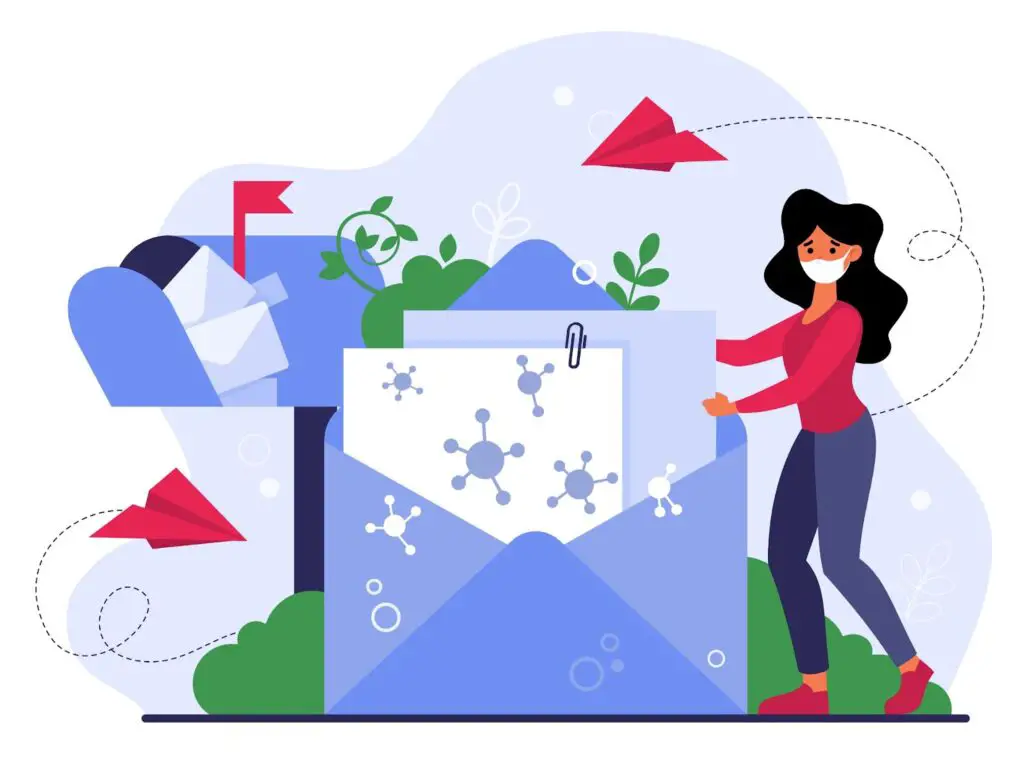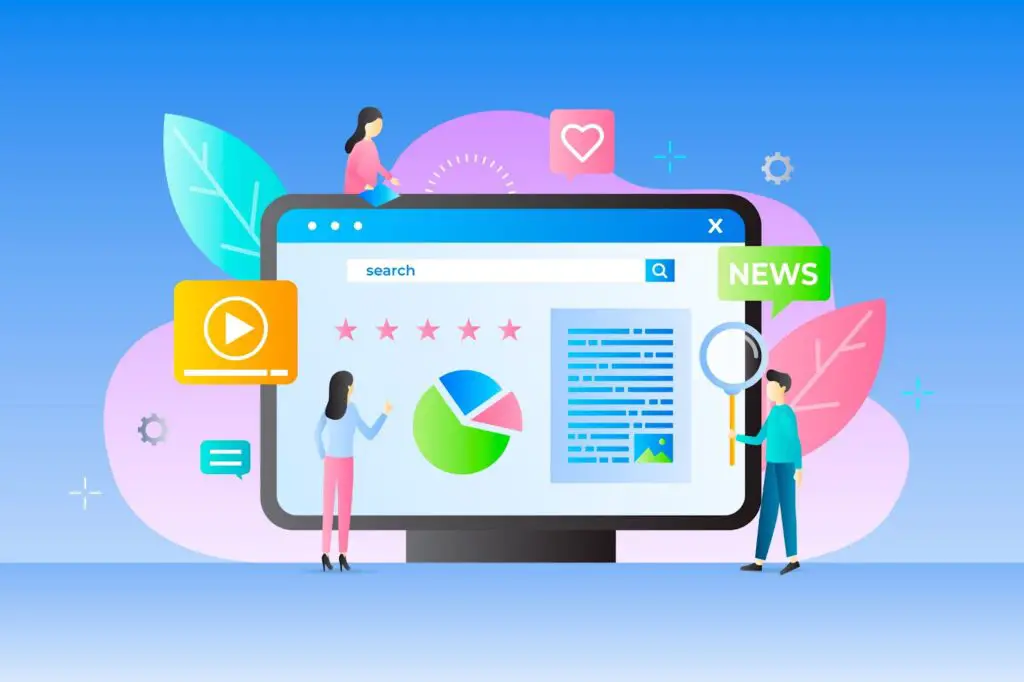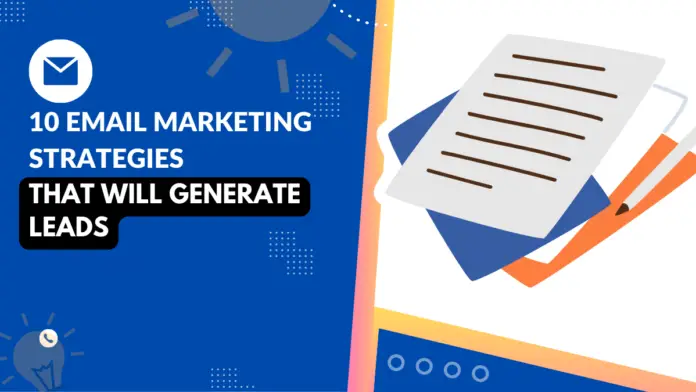Are you looking for a way to increase your leads? Email marketing is a great way to do that! In this blog post, we’ll cover 10 email marketing strategies that will help you generate more leads. From using segmentation to personalizing emails, these strategies will help you maximize your marketing efforts and get more conversions. So let’s dive in and explore how you can use email marketing to get more leads.
1) Segment Your Email List
Email marketing is a great way to reach your target audience, but not all subscribers are the same. That’s why it’s crucial to segment your email list into groups based on demographics, interests, behavior, and other factors. By segmenting your list, you can send more personalized messages to each group, which increases engagement and drives conversions.
One way to segment your email list is to ask subscribers to fill out a survey or preference center. You can then use the data collected to group subscribers by their interests, purchasing behavior, or other characteristics. For example, if you sell women’s clothing, you could segment your list by age, clothing size, and style preferences.
Another way to segment your list is by past behavior. For instance, you could create segments for subscribers who have opened an email in the last 30 days, those who haven’t opened an email in a while, or those who have made a purchase in the last six months.
Segmenting your email list can help you send more targeted messages that resonate with your subscribers. It can also reduce the likelihood of unsubscribes and spam complaints because subscribers will receive emails that are relevant to them.
To get started with segmenting your email list, identify the key data points that will be most valuable to your business and create segments based on those data points. As you collect more data, continue to refine your segments to ensure they remain effective.
For Example:
Segmenting your email list in the education industry, specifically for a teacher email list, can significantly improve your communication and engagement. One effective way to segment is based on grade level. By categorizing teachers according to the grade they teach, you can tailor your content to their specific needs and challenges. For instance, you could create separate email campaigns focusing on elementary, middle school, and high school educators. This allows you to provide grade-level specific resources, lesson plans, and teaching strategies, enhancing their relevance and value. By segmenting your teacher email list based on grade level, you can better address their unique requirements, leading to higher engagement and a stronger connection with your audience.
2) Personalize Your Emails
In the world of email marketing, personalization is king. People don’t want to receive generic messages that don’t address their individual needs or interests. They want to feel like you’re speaking directly to them and offering solutions that fit their specific situations. So, how do you personalize your emails and make them more effective? Here are a few tips:
1. Use the recipient’s name:
This may seem like a no-brainer, but addressing your subscribers by their first name is a simple way to make your emails more personal. It’s a small touch, but it can go a long way in building trust and rapport with your audience.
2. Segment your list:
As we discussed earlier, segmenting your email list allows you to send more targeted messages to specific groups of people. By dividing your list based on demographics, behavior, or other factors, you can create more personalized messages that speak directly to their interests and needs.
3. Use dynamic content:
Dynamic content allows you to create different versions of the same email that are tailored to different segments of your list. For example, you could send a different message to someone who has already made a purchase versus someone who is still considering it.
4. Customize your messaging:
Use the information you have about your subscribers to craft messages that speak directly to them. For example, if someone has previously expressed interest in a particular product, you could send them an email highlighting that product’s features and benefits.
Personalization is all about making your subscribers feel seen and heard. By implementing these strategies, you can create emails that resonate with your audience and drive more leads to your business.

3) Write Engaging Subject Lines
One of the most critical elements of an email marketing campaign is the subject line. It’s the first thing your audience will see when they receive your email in their inbox, and it plays a crucial role in whether or not they’ll open it.
Here are some tips for writing engaging subject lines:
1. Keep it short and sweet.
A subject line that’s too long will get cut off on most devices, so aim for 50 characters or less.
2. Be specific.
Let your audience know what to expect from the email and why they should open it. For example, instead of “Our latest news,” try “5 insider tips to grow your business.“
3. Use personalization.
Including the recipient’s name or other personalized information can make your email stand out in a crowded inbox.
4. Create a sense of urgency.
Limited-time offers or deadlines can motivate recipients to take action.
5. Ask a question.
Questions in subject lines can pique curiosity and encourage engagement.
6. Use numbers.
Lists and numbered headlines are a proven way to grab attention.
7. Test different subject lines.
A/B testing can help you determine which subject lines work best for your audience.
Remember, the subject line is just the first step. Make sure the content of your email delivers on the promise of the subject line and provides value to your audience.
4) Create High-Quality Content
Creating high-quality content is one of the most important elements of any successful email marketing campaign. Your emails need to offer something valuable to your subscribers, something that will entice them to open and read your emails.
The first step to creating high-quality content is to understand your audience. What do they want? What are their pain points? What are their goals? Once you have a clear understanding of your audience, you can create content that speaks directly to them.
When creating content, make sure it is relevant, informative, and engaging. This can include anything from blog posts and articles to videos, infographics, and white papers. The key is to create content that provides value and solves a problem for your subscribers.


Another important aspect of creating high-quality content is to focus on quality over quantity. Sending out a lot of emails is great, but if the content is low-quality, you will not generate the results you desire. Instead, focus on creating fewer, high-quality emails that offer value to your subscribers.
Finally, make sure your content is easy to read and visually appealing. Use formatting, headings, and bullet points to break up the text and make it easy to scan. Also, include images and other visuals to enhance your content and make it more engaging.
By following these tips, you can create high-quality content that resonates with your audience and helps you generate more leads through email marketing.
5) Include a Call-to-Action (CTA)
Once you have created an engaging email, it’s important to prompt your subscribers to take a specific action. This is where your Call-to-Action (CTA) comes in. The CTA can be a button or a hyperlink that directs the subscriber to your website or a landing page.
The key to an effective CTA is to make it clear, concise, and easy to follow. Here are a few tips to make your CTA stand out:
1. Be specific:
Tell your subscribers exactly what you want them to do. If you want them to visit a specific page on your website, say so.
2. Use action-oriented language:
Verbs such as “Click Here” or “Download Now” are action-oriented and motivate subscribers to take action.
3. Make it visible:
Use contrasting colors, bold text, and a clear font to make your CTA stand out.
4. Include a sense of urgency:
Adding phrases such as “Limited Time Offer” or “Sale Ends Soon” can create a sense of urgency that motivates subscribers to act quickly.
5. Test your CTAs:
Try different CTAs in your emails to see which ones generate the best response. You can use A/B testing to compare the effectiveness of different CTAs.
Remember, the purpose of your email marketing campaign is to generate leads. An effective CTA can help you achieve that goal by directing subscribers to your website or landing page where they can take the next step in the sales process.
6) Use Visuals to Enhance Your Email
The saying “a picture is worth a thousand words” holds true for email marketing. Including visuals in your email content can make your emails more attractive and memorable for subscribers. Here are some tips for using visuals in your email marketing strategy:
1. Use High-Quality Images:
When using visuals in your email, ensure that they are high-quality images that enhance the message you are trying to convey. Grainy or blurry images can turn off subscribers and negatively impact their perception of your brand.
2. Choose Relevant Images:
Select images that relate to the message of your email. Avoid using generic images that have nothing to do with your content, as they can confuse your subscribers.
3. Keep the Image Size in Check:
Too many large images in your email can slow down load times, leading to frustrated subscribers. Resize your images and optimize them for faster loading times.
4. Use Animated GIFs:
Animated GIFs are an excellent way to grab attention and engage subscribers. However, be mindful of how you use them. Avoid excessive animation or GIFs that may appear spammy.
5. Incorporate Videos:
Videos are an excellent way to showcase your brand’s personality and convey complex messages. They can help keep subscribers engaged and interested in your content.
By using visuals effectively, you can take your email marketing strategy to the next level. Keep in mind that every subscriber’s experience is different, so test different visuals to find out what resonates with your audience.
7) Test Your Emails for Optimal Performance
Email marketing campaigns are a powerful way to connect with potential customers and generate leads for your business. However, simply sending out an email blast is not enough to ensure success. To get the best possible results, you need to test your emails for optimal performance. Here are some tips to help you do just that:
1. Conduct A/B Testing:
A/B testing is the practice of sending two different versions of the same email to a small group of your email list to see which one performs better. This can help you determine the best subject line, CTA, or content format for your email campaigns.
2. Test for Different Devices:
With the majority of emails being opened on mobile devices, it’s important to test how your emails look and perform on both mobile and desktop devices. Make sure your email is easy to read, images are appropriately sized, and all links work on both devices.
3. Review Spam Scores:
Spam filters can prevent your email from reaching your target audience, so it’s important to keep an eye on your email’s spam score. This can help you avoid common spam triggers such as using too many exclamation points or using too many keywords.
4. Check Load Time:
The load time of your email can significantly impact engagement rates. Ensure that all images and content are optimized for fast loading speed, and avoid using too many large images.
5. Monitor Engagement Metrics:
Pay close attention to open rates, click-through rates, and conversion rates. This can help you gauge the effectiveness of your email marketing campaigns and identify areas for improvement.
By testing your emails for optimal performance, you can improve engagement rates and generate more leads for your business. Remember to continually review and adjust your email marketing strategies based on the results of your testing.
8) Send Emails at the Right Time
Timing is crucial when it comes to email marketing. If you send your emails at the wrong time, they are likely to be ignored or forgotten. So, how do you determine the best time to send your emails? Here are some tips:


1. Consider your audience:
Think about when your target audience is most likely to check their emails. Are they early birds who check their inbox first thing in the morning, or do they prefer to check their emails later in the day? Analyzing their behavior patterns can help you decide on the best time to send your emails.
2. Test different times:
Experiment with different times and days of the week to find the sweet spot for your audience. Some people might respond better to emails sent on weekdays, while others might prefer weekends.
3. Keep time zones in mind:
If you have an international audience, make sure you send your emails at a time that suits all time zones. For example, if you are based in the US but have subscribers in Europe, consider sending your emails in the early morning, when it’s still afternoon in Europe.
4. Take into account the purpose of your email:
Different types of emails might perform better at different times. For example, if you are sending a promotional email, it might be better to send it on a Friday when people are getting ready for the weekend and are more likely to make a buy.
By sending your emails at the right time, you increase the chances of your audience opening and engaging with them, leading to better conversions and ultimately, more leads. So, take the time to analyze your audience behavior, experiment with different times, and track your email metrics to find the optimal time to send your emails.
9) Monitor and Analyze Your Email Metrics
After sending out your emails, it’s important to monitor and analyze your email metrics to determine the success of your campaign. This includes open rates, click-through rates, bounce rates, and conversion rates. By analyzing these metrics, you can identify which emails were successful and which ones weren’t.
Start by reviewing your open rates, which tell you how many people opened your email. If your open rates are low, you may want to consider changing your subject lines or personalizing your emails to make them more engaging. Next, look at your click-through rates, which tell you how many people clicked on links in your email. If your click-through rates are low, you may want to consider changing the location or wording of your CTAs.
Bounce rates are also important to monitor, as they tell you how many of your emails were undeliverable. High bounce rates can indicate issues with your email list or content and may require you to update or clean your email list. Lastly, conversion rates tell you how many people completed the desired action after clicking through your email, such as making a purchase or filling out a form. If your conversion rates are low, you may want to reevaluate your landing page or CTA.
By monitoring and analyzing your email metrics, you can make data-driven decisions to improve your email marketing strategy and generate more leads. Use this information to refine your email content, optimize your timing, and personalize your emails to deliver the best results possible.
10) Optimize Your Landing Pages for Conversion.
So, you’ve sent out an amazing email to your subscribers with all the bells and whistles – engaging subject line, personalized content, and eye-catching visuals – but now what? The next step in generating leads through email marketing is optimizing your landing pages for conversion.
What exactly does that mean?
A landing page is a webpage a subscriber is directed to after clicking on a link in your email. It’s essential to make sure that this page is optimized for conversion, meaning it should be designed in a way that persuades the subscriber to take a specific action, such as making a purchase or filling out a form.
Here are a few tips for optimizing your landing pages for conversion:
1. Keep It Simple:
Your landing page should be easy to navigate and visually appealing, with clear and concise messaging that matches the content of your email.
2. Use a Strong Headline:
Your headline should clearly state the value proposition and what action the subscriber should take, such as “Sign up now for 10% off your first purchase.”
3. Include a Clear Call-to-Action:
Your call-to-action (CTA) should be prominent and easy to find, with action-oriented language that encourages the subscriber to take the desired action.
4. Minimize Distractions:
Remove any unnecessary links, ads, or pop-ups that may distract the subscriber from completing the desired action.
5. Test, Test, Test:
Test different versions of your landing pages to see which designs, headlines, and CTAs perform best, and make adjustments accordingly.
Optimizing your landing pages for conversion is essential for turning email subscribers into paying customers. By implementing these tips, you can improve the effectiveness of your email marketing campaigns and generate more leads for your business.
Conclusion
Email marketing is a powerful tool for generating leads. Here are 10 strategies to maximize its effectiveness. Firstly, build a targeted and segmented email list to ensure you’re reaching the right audience. Secondly, create compelling subject lines that grab attention and entice recipients to open your emails. Thirdly, personalize your emails to make them more relevant and engaging. Fourthly, craft valuable and informative content that addresses the needs and interests of your subscribers. Fifthly, include clear call-to-actions that direct readers to take the desired action.
Sixthly, optimize your emails for mobile devices to reach a wider audience. Seventhly, use A/B testing to refine your email campaigns for better performance. Eighthly, automate your email sequences to nurture leads and build relationships. Ninthly, leverage social proof and testimonials to establish credibility and trust. Lastly, regularly analyze your email metrics to identify areas for improvement and adjust your strategies accordingly.
Waqar Hussain is the founder of The Business Goals. He writes about entrepreneurial strategies and is an SEO consultant by profession. He is a B.Com, GDM, and an MBA from the Australian Institute of Business.
















































